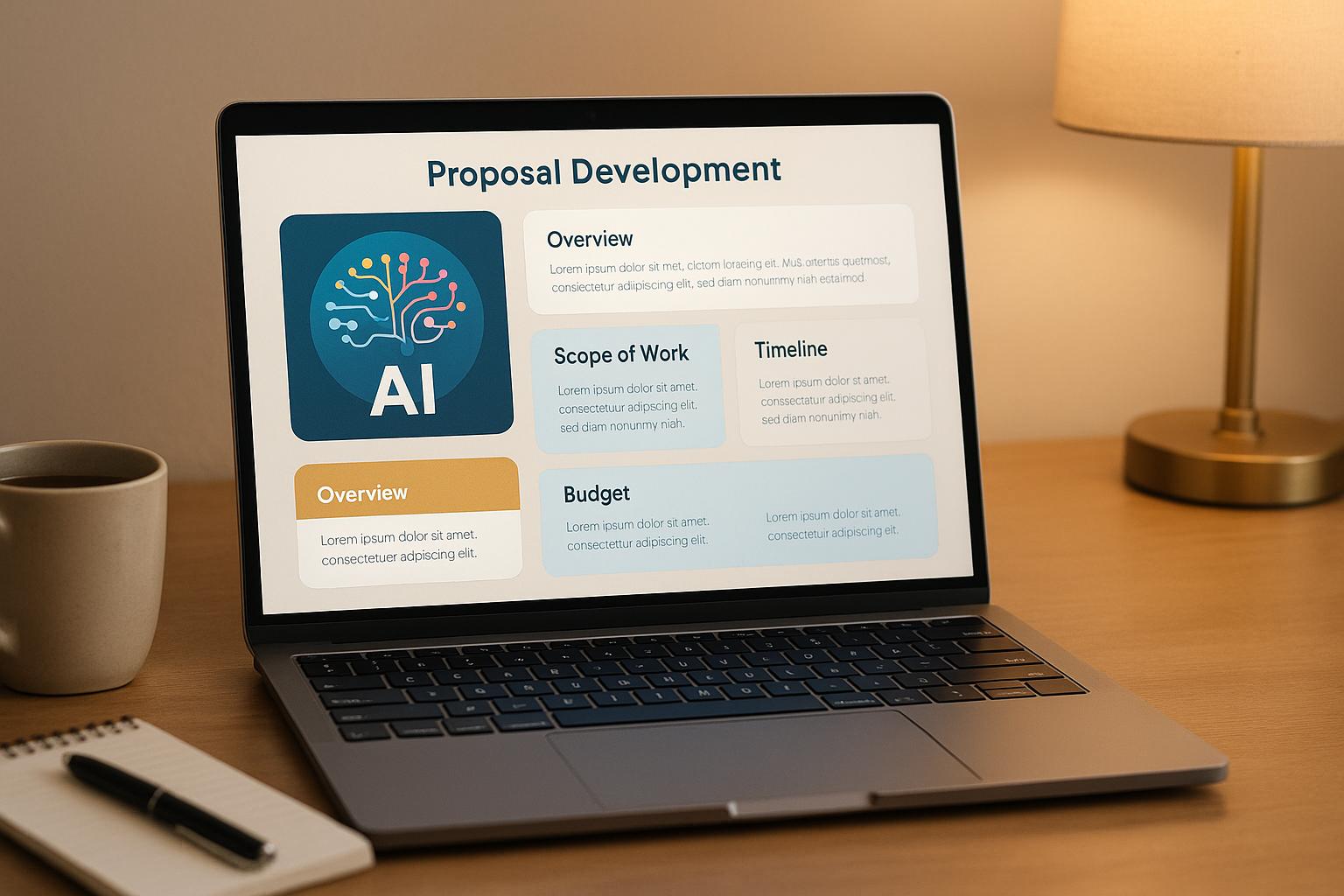AI milestone tracking is transforming how businesses plan and execute projects. By automating progress monitoring, identifying risks, and optimizing resources, AI helps businesses stay on schedule and meet goals efficiently. Here's what you need to know:
- Milestone Tracking Basics: Milestones are key checkpoints in a project. Tracking them ensures deadlines, budgets, and outcomes stay on track.
- AI’s Role: AI automates data collection, integrates information across departments, and provides real-time alerts for potential issues.
-
Key Benefits:
- Instant progress updates.
- Early risk detection.
- Better resource management and cost savings.
-
Implementation Steps:
- Define your goals and tracking needs.
- Choose AI tools that integrate with your systems.
- Train users and monitor system performance.
AI tools, like StratEngineAI, streamline planning by combining milestone tracking with broader project insights. The result? Faster decisions and fewer delays. To maximize success, focus on clean data, user training, and dashboards tailored to your team’s needs.
Writing Project Roadmap Using ChatGPT and AI

Key Benefits of AI in Milestone Tracking
AI-driven milestone tracking makes strategic planning smoother and more efficient. These advancements bring clear advantages for decision-makers, helping them stay ahead in managing projects and resources.
Real-Time Updates and Automation
Gone are the days of waiting for periodic updates. With AI, milestone tracking becomes a dynamic, ongoing process. AI gathers and consolidates data from across the organization in real time, cutting out delays. By integrating seamlessly with business tools, it automates data collection, freeing up teams to focus on more strategic, high-impact work. This constant visibility not only keeps everyone informed but also allows for quick adjustments whenever delays or obstacles emerge, ensuring projects stay on course.
Smarter Risk Identification and Prevention
One of AI’s standout abilities is spotting patterns that might signal trouble. By analyzing both historical and current data, AI can detect potential risks early - risks that might otherwise slip through the cracks. It also keeps an eye on key performance metrics, giving organizations the chance to take action before small issues grow into major problems. This proactive approach means strategies can be adjusted, and resources can be shifted to address challenges before they escalate.
Efficient Resource Allocation and Cost Savings
AI takes the guesswork out of resource management. By analyzing how resources are being used across various initiatives, it identifies inefficiencies like underused assets or bottlenecks. This insight allows organizations to reallocate budgets and talent effectively. The financial benefits are clear: less time spent on manual tasks, fewer project delays, and early detection of risks that could lead to costly overruns. Plus, AI’s ability to forecast resource needs for different project stages helps teams plan better, reducing the need for expensive, last-minute adjustments and paving the way for smarter, data-backed decisions.
Step-by-Step Guide to Implementing AI Milestone Tracking
To successfully implement AI milestone tracking, start with a clear and structured plan that aligns with your organization's specific needs. Here's how to get started:
Define Business Objectives and Requirements
Before diving into AI solutions, take a step back and clearly define your goals and the challenges you aim to address.
Start by auditing your current strategic planning process. Identify areas where delays occur, pinpoint critical milestones, and highlight bottlenecks in your manual tracking systems. For small-to-medium business (SMB) executives, this could involve reviewing quarterly business plans, product launches, or market expansion timelines. Consultants might focus on streamlining client deliverables, managing project phases, or improving resource allocation across engagements.
Next, set clear tracking requirements. Determine which teams - whether it's sales, marketing, IT, or engineering - need visibility into milestones. Decide how often updates are necessary, such as daily progress reports or weekly reviews, and define the level of detail required. Some organizations may prefer high-level dashboards for executives, while others might need detailed task-level tracking.
Document your success metrics at the outset. Think about what successful milestone tracking looks like for your organization. Are you aiming to reduce project delays, improve resource efficiency, or speed up decision-making? Having these benchmarks in place will help you assess the effectiveness of your AI solution and measure its impact.
Once your objectives are clear, move on to selecting the right platform.
Choose the Right AI Tools or Platforms
The market offers a variety of AI tools for milestone tracking, ranging from simple solutions to comprehensive platforms. Choose one that fits both your immediate tracking needs and long-term strategic goals.
Start by evaluating integration capabilities. The best AI tools seamlessly connect with your existing systems, such as project management software, CRM tools, financial platforms, and communication channels. This ensures a unified view of progress across your organization.
Consider platforms that offer strategic planning features alongside milestone tracking. For instance, StratEngineAI combines milestone tracking with strategy-building tools, offering features like market analysis and competitive intelligence. This type of platform not only monitors progress but also helps align milestones with broader strategic objectives.
Look for solutions that incorporate established frameworks like SWOT analysis or Porter's Five Forces. These tools provide a structured way to evaluate progress and ensure your tracking aligns with sound strategic principles.
Finally, assess the ease of use. Some platforms require technical expertise, while others are more user-friendly and designed for immediate adoption. Tools that allow professional, polished exports for presentations can also simplify communication with stakeholders.
Integrate, Train, and Monitor
Once you've chosen a tool, the next step is to integrate it into your workflow and ensure it delivers value. A thoughtful approach will make this process smoother.
Begin with a pilot program. Test the AI tool on a single project or department to gauge its effectiveness without disrupting your entire operation. This trial run will help you identify any issues early on.
Focus on data integration. Connect the AI platform to your existing data sources, ensuring historical information is imported for context. This baseline data helps the AI provide accurate insights into your current milestones. Make sure to clean and validate your data before activating the system.
Tailor training sessions to different user groups. Executives might need guidance on using dashboards, project managers on setting up milestones, and team members on data entry. Customized training ensures everyone is equipped to use the system effectively.
Set up monitoring protocols from the start. Schedule regular reviews to track the tool's performance, assess data accuracy, and measure user adoption. Key metrics to monitor include time saved on manual reporting, milestone completion rates, and the quality of insights generated by the system.
Finally, commit to ongoing refinement. As your strategic priorities shift, update the system to reflect new milestone definitions, metrics, and reporting needs. Regular adjustments ensure the tool remains aligned with your evolving goals and delivers consistent value over time.
sbb-itb-7250072
Best Practices for AI-Driven Milestone Tracking
To truly harness the power of AI for milestone tracking, it's important to go beyond simply implementing the system. Adopting a set of best practices ensures the system delivers reliable insights and supports long-term success.
Use High-Quality Data
An AI system is only as good as the data it processes. If the data is flawed, the insights and decisions derived from it will be too.
Start by defining milestones clearly across your organization. Establish what data is required, how it should be formatted, and how often it needs to be updated. This consistency helps your AI recognize patterns and generate accurate predictions.
Before launching the system, ensure your data is complete. Missing or incomplete information can create gaps that disrupt planning. Historical data - such as start and end dates, resource allocations, budgets, and performance metrics - provides a solid baseline for your AI to identify trends and flag potential issues early.
Regular data audits are essential to maintain quality. Assign team members to spot-check for missing entries, outdated records, or inconsistent formatting. Automated data validation can also help - set up alerts to catch errors like missing fields, mismatched dates, or unrealistic budget figures. Clean, accurate data is the foundation for reliable AI insights.
Get Stakeholder Buy-In and Training
Even the most advanced AI system won’t succeed without widespread adoption. Building organizational support and providing proper training are critical steps.
Start by involving leadership from the outset. When executives back the system and understand its value, it sets the tone for the rest of the organization. Regular updates to leadership about how AI improves decision-making can reinforce this support.
Tailor training programs to different roles. Executives, project managers, and team members all interact with the system differently, so their training should reflect that. Highlight how the system reduces manual tasks, improves deadline management, and increases team visibility. When people see how the system benefits them directly, they’re more likely to embrace it.
To ensure ongoing support, identify internal champions - team members who are enthusiastic about the system and willing to help others. These champions can share success stories, provide guidance, and encourage best practices across departments.
Use Dashboards for Decision-Making
AI-powered dashboards take raw milestone data and turn it into actionable insights. The key is designing dashboards that support decision-making at all levels of the organization.
Focus on real-time updates and health metrics. Dashboards should provide instant visibility into milestone progress, making it easier to identify and address issues quickly. Alerts for at-risk milestones or delayed objectives allow teams to act before problems escalate.
Include AI-driven risk detection features to flag potential delays, budget overruns, or resource shortages. Early warnings enable preemptive solutions, saving time and resources.
Dashboards should also offer a clear view of resource allocation. Highlight bottlenecks, show available capacity, and display how resources are distributed across projects. This transparency supports better planning and coordination.
Integrating data from across departments - like sales, marketing, and operations - creates a more comprehensive view of milestone progress. This cross-functional approach helps uncover dependencies and collaboration opportunities that might otherwise go unnoticed.
Finally, customize dashboards to suit different roles. Executives might prefer high-level overviews, while project managers need detailed task-level data. Incorporating forecasting tools to predict delays or resource needs can further enhance decision-making, ensuring the system remains a valuable tool for everyone involved.
Conclusion: AI as a Strategic Planning Ally
AI-powered milestone tracking is changing the way businesses approach strategic planning. Instead of relying on outdated manual updates and static spreadsheets, companies now have access to intelligent systems that offer real-time updates, highlight potential risks, and streamline resource allocation across projects.
What sets AI apart is its ability to uncover patterns that human planners might overlook. For instance, it can detect trends from past projects that faced delays, turning milestone tracking into a proactive management tool rather than a reactive task.
This transformation offers clear advantages for organizations of all sizes. For smaller businesses and boutique consulting firms, the benefits are especially impactful. Teams can move away from time-consuming manual reporting and focus on making strategic decisions. While the time savings are impressive, the true value lies in the actionable insights AI systems deliver.
Take platforms like StratEngineAI, for example. These tools don’t just track milestones - they integrate the entire strategic planning process, from initial research to final presentations. By connecting milestone tracking with broader strategic frameworks, they provide a unified view of both tactical progress and overall strategic goals. What used to take weeks can now be done in minutes, enabling quicker adjustments and more agile responses.
The real key to success, however, is treating AI as a strategic partner rather than just another productivity tool. Organizations that prioritize high-quality data, secure buy-in from stakeholders, and design dashboards focused on decision-making see the best results. This approach elevates milestone tracking from a routine task to a competitive advantage.
As strategic planning evolves, AI-powered milestone tracking will become indispensable for businesses aiming to stay agile and competitive in today’s fast-paced markets.
FAQs
How does AI assist in identifying and managing risks during strategic planning?
AI plays a key role in improving how businesses identify and manage risks during strategic planning. By analyzing massive amounts of data, it can reveal threats and opportunities that might go unnoticed through traditional methods.
With the help of advanced algorithms, AI enables decision-makers to predict potential challenges and craft strategies to address them before they escalate. This creates a more responsive and well-informed path toward achieving business goals.
How can companies effectively implement AI for tracking milestones in strategic planning?
To make the most of AI in milestone tracking for strategic planning, companies need to ensure these tools align closely with their specific objectives and processes. Begin by clearly defining the milestones that matter most and integrating AI to handle tracking tasks. This approach not only automates updates but also delivers real-time insights that keep all stakeholders in the loop.
Customization is another key step. Adjust AI systems to fit your needs - this could mean setting up tailored dashboards, creating alerts for important milestones, or adapting the platform to match your strategic planning framework. Don’t overlook the importance of team training either. By equipping your team with the know-how to use AI effectively, you’ll empower them to make quicker, smarter decisions as they navigate the process.
How can businesses ensure their data is accurate and dependable for AI to track milestones effectively?
To ensure your AI-driven milestone tracking delivers reliable results, focusing on data quality management is crucial. Begin by checking the reliability of your data sources and putting strong validation processes in place to catch any errors as early as possible. Regular audits are also key - these help you spot inconsistencies or outdated information, so you can address them quickly and keep your data accurate.
On top of that, clear data governance practices are a must. Set standards for how data is entered and who can access it. By doing this, you ensure your AI system has access to accurate, up-to-date information, allowing it to track milestones effectively and provide solid support for your strategic decisions.

